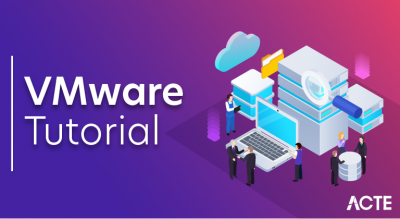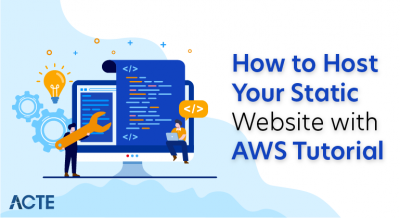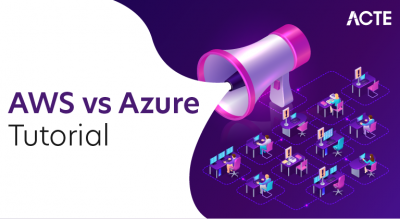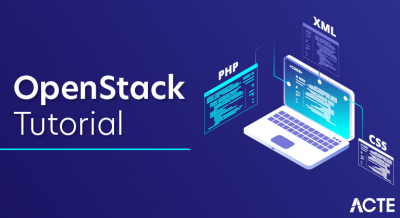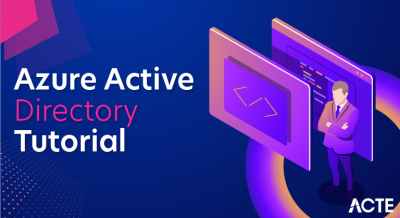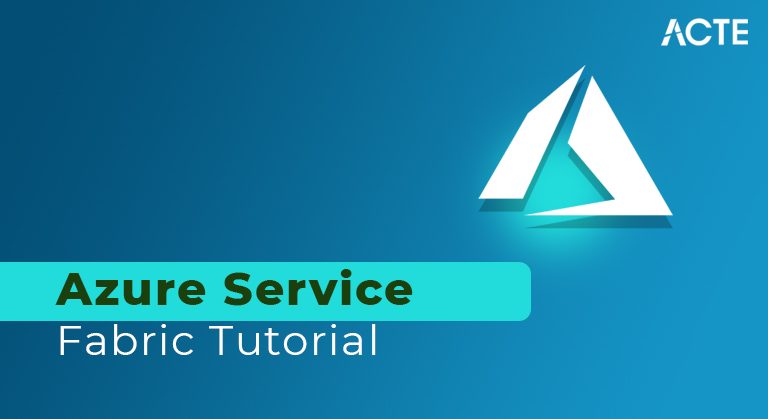
- Introduction to Azure Service Fabric
- What is Azure Service Fabric service?
- What is Azure Service Fabric cluster?
- What is the Service Fabric project?
- What is data Fabric Azure?
- History of Azure Service Fabric
- Basic concepts of Azure Service Fabric
- Subsystem
- Azure Service Fabric Programming Models
- Applications and infrastructure
- Application architecture
- Advantages
- Prerequisites
- Conclusion of SAP Fiori
- Highly available
- Scalable
- Manageable
- Testable
- Transport subsystem
- Federation subsystem
- Reliability subsystem
- Management subsystem
- Hosting subsystem
- Communication subsystem
- Testability subsystem
- To reason about a set of nodes in a distributed system, you need to have a consistent view of the system. The federation subsystem uses the communication primitives provided by the transport subsystem and stitches the various nodes into a single unified cluster that it can reason about. It provides the distributed systems primitives needed by the other subsystems – failure detection, leader election, and consistent routing.
- The federation subsystem is built on top of distributed hash tables with a 128-bit token space. The subsystem creates a ring topology over the nodes, with each node in the ring being allocated a subset of the token space for ownership. For failure detection, the layer uses a leasing mechanism based on heart beating and arbitration.
- The federation subsystem also guarantees through intricate join and departure protocols that only a single owner of a token exists at any time. This provides leader election and consistent routing guarantees.
- The reliability subsystem provides the mechanism to make the state of a Service Fabric service highly available through the use of the Replicator, Failover Manager, and Resource Balancer.
- The Replicator ensures that state changes in the primary service replica will automatically be replicated to secondary replicas, maintaining consistency between the primary and secondary replicas in a service replica set. The replicator is responsible for quorum management among the replicas in the replica set. It interacts with the failover unit to get the list of operations to replicate, and the reconfiguration agent provides it with the configuration of the replica set. That configuration indicates which replicas the operations need to be replicated. Service Fabric provides a default replicator called Fabric Replicator, which can be used by the programming model API to make the service state highly available and reliable.
- The Failover Manager ensures that when nodes are added to or removed from the cluster, the load is automatically redistributed across the available nodes. If a node in the cluster fails, the cluster will automatically reconfigure the service replicas to maintain availability.
- The Resource Manager places service replicas across failure domains in the cluster and ensures that all failover units are operational. The Resource Manager also balances service resources across the underlying shared pool of cluster nodes to achieve optimal uniform load distribution.
- Explore pricing options.
- Apply filters to customize pricing options to your needs.
- Prices are estimates only and are not intended as actual price quotes. Actual pricing may vary depending on the type of agreement entered with Microsoft, date of purchase, and the currency exchange rate.
- Prices are calculated based on US dollars and converted using Thomson Reuters benchmark rates refreshed on the first day of each calendar month. Sign in to the Azure pricing calculator to see pricing based on your current program/offer with Microsoft. Contact an Azure sales specialist for more pricing information or to request a price quote. See frequently asked questions about Azure pricing.
- Permissioned membership
- Performance, scalability, and levels of trust
- Data on a need-to-know basis
- Rich queries over an immutable distributed ledger
- The modular architecture supporting plug-in components
- Protection of digital keys and sensitive data
- NET 4.6.2 developer pac
- Azure Service Fabric 2.6 (or above) SDK
- Visual Studio 2017
- General knowledge of IT architecture
- General knowledge of software containers
- With more than 200 services and numerous benefits, Microsoft Azure is undoubtedly the fastest-growing cloud computing platform being adopted by businesses. Microsoft Azure’s total revenue is expected to surpass $19 billion by 2020. This growth in the implementation of Azure by businesses is creating various opportunities for professionals well-versed in this technology.
- So, if you are interested in a career in Azure, this is the right time to jump in. The best way to start your career in Azure is by getting certified. You can find various online Azure certification training that can help you learn the nuances of Azure and excel in. The Azure certification exams. One of them is Simplilearn’s Microsoft Certified Azure Architect Design (AZ-301) Training Course.
- So, what are you waiting for? Get certified in Microsoft Azure and move toward having a great career.Communication and workflow. The communication between different tiers in the case of cloud service and service in the case of Service Fabric happens commonly in two models: direct and via an external durable storage. In cloud services, tiers communicate directly by selecting the instance of the VM role and connecting to the endpoint directly, while in service fabric we just connect to a service
Introduction to Azure Service Fabric:
It is an architecture embracing the microservice architecture where developers disrupt the traditional monolithic applications into a set of discrete and fine-grained services. With the introduction of the Cloud, scaling and reliability have taken a new revolution in implementing in different ways across the whole system. Agility is the main concern where we need to ship products more frequently and independently. Developers think about factors like latency requirements, availability, speed more than the real feature itself. About Azure Service Fabric service.
What is Azure Service Fabric service?
Azure Service Fabric is a distributed systems platform that makes it easy to package, deploy, and manage scalable and reliable microservices and containers. You can create Service Fabric clusters anywhere, including Windows Server and Linux on-premises and other public clouds, in addition to Azure.
What is Azure Service Fabric cluster?
A Service Fabric cluster is a network-connected set of virtual or physical machines into which your microservices are deployed and managed. Service Fabric allows for the creation of Service Fabric clusters on any VMs or computers running Windows Server or Linux.
What is the Service Fabric project?
The Service Fabric SDK contains PowerShell cmdlets for deploying an application from a given folder on a disk. The Service Fabric application projects provide targets that can be accessed via MS Build, or used directly from Visual Studio, to package the content of that folder.
What is data Fabric Azure?
Data Fabric feature, connect multiple clouds. No data movement required, on-prem, cloud1, cloud2, cloud3, on-prem2 integrate data no data movement. azure and aws also supported.
History of Azure Service Fabric:
In 2005, Microsoft took over Groove Networks, and Bill Gates made Grooves founder Ray Ozzie one of his 5 direct reports as one of 3 chief technology officers. Ozzie met with Amitabh Srivastava, which let Srivastava change course. They convinced Dave Cutler to postpone his retirement and their teams developed a cloud operating system Azure Automation provides a way for users to automate the manual, long-running, error-prone, and frequently repeated tasks that are commonly performed in a cloud and enterprise environment. It saves time increases the reliability of regular administrative tasks and even schedules them to be automatically performed at regular intervals. You can automate processes using runbooks or automate configuration management using Desired State Configuration Azure functions are used in serverless computing architectures where subscribers can execute code as an event-driven Function-as-a-Service (FaaS) without managing the underlying server resources.
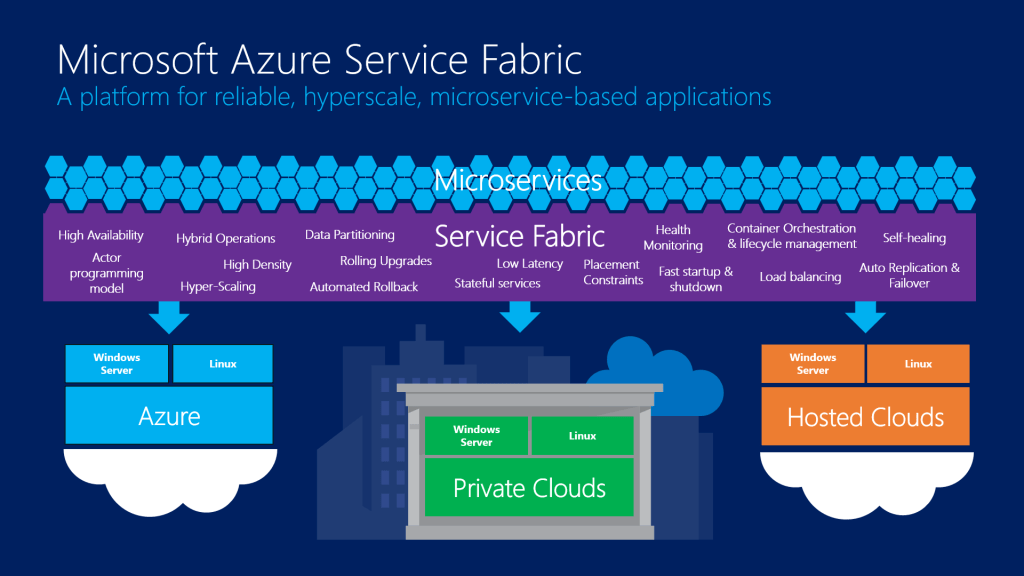
Basic concepts of Azure Service Fabric:-
Service type:
This is your service implementation. It is defined by the class you write that extends StatelessService and any other code or dependencies used therein, along with a name and a version number.
Named service instance:
To run your service, you create named instances of your service type, much like you create object instances of a class type. A service instance has a name in the form of a URI using the “fabric:/” scheme, such as “fabric:/MyApp/MyService”.
Service host:
The named service instances you create need to run inside a host process. The service host is just a process where instances of your service can run.
Service registration:
Registration brings everything together. The service type must be registered with the Service Fabric runtime in a service host to allow Service Fabric to create instances of it to run. Deployment models Microsoft Azure offers two deployment models for cloud resources: the “classic” deployment model and the Azure Resource Manager.In the classic model, each Azure resource (virtual machine, SQL database, etc.) was managed individually. The Azure Resource Manager, introduced in 2014, enables users to create groups of related services so that closely coupled resources can be deployed, managed, and monitored together.
Microservices in Azure Apart from the deprecated Azure Cloud Services there are three main options:
1. Azure Container Service Microsoft’s implementation of open-source container technologies based on Docker.
2. Azure Service Fabric Allows focusing on business objectives and not infrastructure.
3. Azure Functions Another viable option to build microservices, allows you to write functions in a language of your choice directly on the Azure portal. Each function essentially becomes a mini version of a microservice
There are three different approaches to creating a microservice in Service Fabric:
1. Reliable Services: Easiest way to start with Service Fabric, as they are similar and at times identical to a usual windows service. Most of the time similar to a console application. Further, they are divided into two subtypes. Stateless Services, which many ways looked and acted as a console application, and Stateful microservices which are state of the art, self-contained microservice with their own transactional replicated storage. This write-up describes the Stateless Services in Service Fabric.
2. Reliable Actors: Virtual actor design pattern and it is built on top of stateful Reliable Service framework. Suitable for handling a massive amount of client requests with large compute and scale.
3. Guest Executables: Ability to take any application, written in any language to run it with Service Fabric after a few configuration changes. Service Fabric architecture Service Fabric is built with layered subsystems.

Subsystem :-
These subsystems enable you to write applications:
Service Fabric provides the ability to resolve service locations through its communication subsystem. The application programming models exposed to developers are layered on top of these subsystems along with the application model to enable tooling.
Transport subsystem:
The transport subsystem implements a point-to-point datagram communication channel. This channel is used for communication within service fabric clusters and communication between the service fabric cluster and clients. It supports one-way and request-reply communication patterns, which provides the basis for implementing broadcast and multicast in the Federation layer. The transport subsystem secures communication by using X509 certificates or Windows security. This subsystem is used internally by Service Fabric and is not directly accessible to developers for application programming.
Federation subsystem:
Reliability subsystem:
Management subsystem:
The management subsystem provides end-to-end service and application lifecycle management. PowerShell cmdlets and administrative APIs enable you to provision, deploy, patch, upgrade, and de-provision applications without loss of availability. The management subsystem performs this through the following services. Cluster Manager: This is the primary service that interacts with the Failover Manager from reliability to place the applications on the nodes based on the service placement constraints. The Resource Manager in failover subsystem ensures that the constraints are never broken. The cluster manager manages the lifecycle of the applications from provision to de-provision. It integrates with the health manager to ensure that application availability is not lost from a semantic health perspective during upgrades.
Health Manager:
This service enables health monitoring of applications, services, and cluster entities. Cluster entities (such as nodes, service partitions, and replicas) can report health information, which is then aggregated into the centralized health store. This health information provides an overall point-in-time health snapshot of the services and nodes distributed across multiple nodes in the cluster, enabling you to take any needed corrective actions. Health query APIs enable you to query the health events reported to the health subsystem. The health query APIs return the raw health data stored in the health store or the aggregated, interpreted health data for a specific cluster entity.
Hosting subsystem:
The cluster manager informs the hosting subsystem (running on each node) which services it needs to manage for a particular node. The hosting subsystem then manages the lifecycle of the application on that node. It interacts with the reliability and health components to ensure that the replicas are properly placed and are healthy.
Communication subsystem:
This subsystem provides reliable messaging within the cluster and service discovery through the Naming service. The Naming service resolves service names to a location in the cluster and enables users to manage service names and properties. Using the Naming service, clients can securely communicate with any node in the cluster to resolve a service name and retrieve service metadata. Using a simple Naming client API, users of Service Fabric can develop services and clients capable of resolving the current network location despite node dynamism or the re-sizing of the cluster.
Testability subsystem:
Testability is a suite of tools specifically designed for testing services built on Service Fabric. The tools let a developer easily induce meaningful faults and run test scenarios to exercise and validate the numerous states and transitions that a service will experience throughout its lifetime, all in a controlled and safe manner. Testability also provides a mechanism to run longer tests that can iterate through various possible failures without losing availability. This provides you with a test-in-production environment.
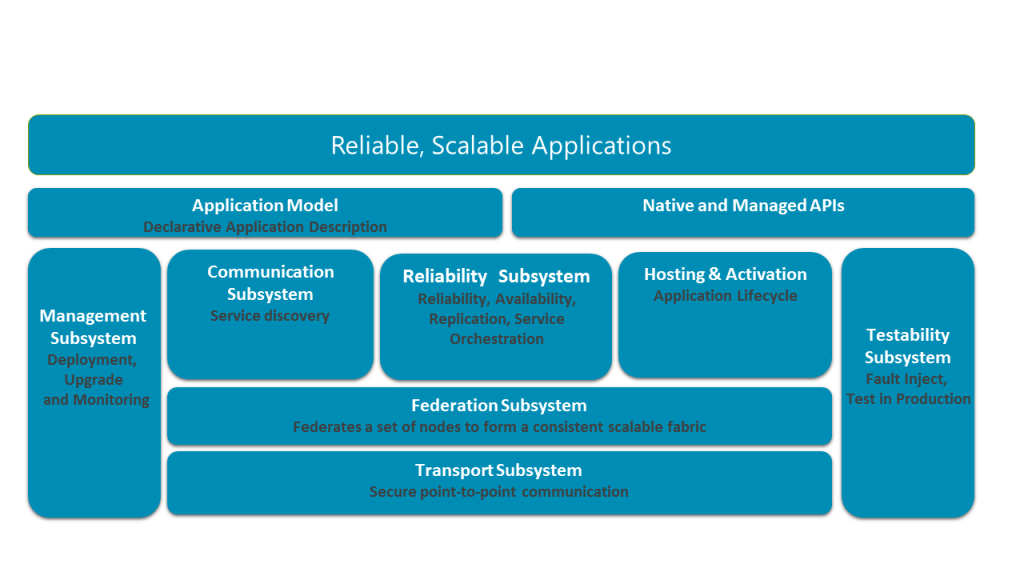
Azure Service Fabric Programming Models :-
In Azure Service Fabric, the services can be written in any type of language or code running in a container host or cluster by using the Service Fabric APIs to take full advantage of the platform’s features and application frameworks.
Guest executables: Any existing or arbitrary executable code written in any language can be run as guest executables in service fabric. They are placed on nodes in the cluster but can’t directly call the Service Fabric SDK APIs. But will still benefit features from the platform like health monitoring, density, discoverability, load reporting, and full application lifecycle management
Containers: You can deploy Linux/Windows containers in Service Fabric without any changes to your application. In the same application, you can have a combination of both services in processes and services in containers. Service Fabric stateless or stateful reliable services or Reliable Actors in containers
Reliable Services: Service Fabrics own programming models for gaining some additional features which are lightweight, powerful, and help you to express what is important to your application. This is automatically managed by Service Fabric and can be stateless or stateful. Features like replication and partitioning make reliable services highly available.
ASP.NET Core: Service Fabric integrates with ASP.NET Core supporting both stateless and stateful applications with an added advantage of Reliable Collections advanced orchestration capabilities.
Reliable Actors: An application framework, built on top of Reliable Services, which implements the Virtual Actor pattern. It will be based on the actor design pattern and can benefit all the features offered by the Azure Service Fabric platform.
Applications and infrastructure :-
In Cloud Services we deploy applications as Virtual Machines where the code is coupled to an instance. There is no difference between an application and VM definition here as both are considered as one, while in Service Fabric we just deploy our applications into existing virtual machines where the service is completely decoupled from the underlying infrastructure.
Application architecture :-
We might be having a lot of external service dependencies in cloud service architecture like tables, storage, and cache. The service fabric can also follow the same by just replacing the cloud service deployment with the service fabric stateless services in a simple migration with minimal code change or using stateful features by writing some custom services.
Communication and workflow :-
The communication between different tiers in the case of cloud service and service in the case of Service Fabric happens commonly in two models: direct and via an external durable storage. In cloud services, tiers communicate directly by selecting the instance of the VM role and connecting to the endpoint directly, while in service fabric we just connect to a service
Availability and resiliency planning:
Service Fabric spreads VM instances across fault and updates domains to ensure maximum availability and resilience. For an enterprise-scale production cluster, as a minimum target the silver tier (5-node cluster) for reliability and durability when hosting containerized stateless web applications.
Availability and resiliency planning:
Service Fabric spreads VM instances across fault and updates domains to ensure maximum availability and resilience. For an enterprise-scale production cluster, as a minimum target the Silver tier (5-node cluster) for reliability and durability when hosting containerized stateless web applications. Azure and move toward having a great career.
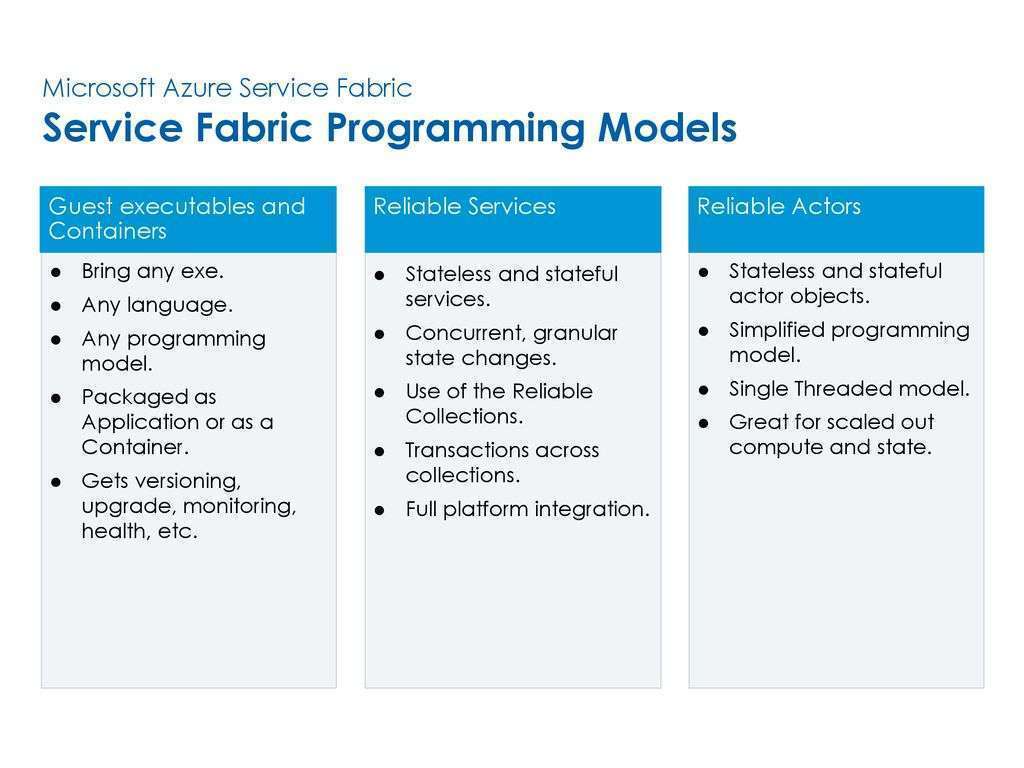
Scope:
Currently, the Azure App Service platform contains these services:
Web Apps: For running web and API applications in Azure
Mobile Apps: For running the backend for mobile applications in Azure
Function Apps: For running small blocks of code in Azure that can be triggered by outside sources, like a message on a queue. You can configure the Azure Monitor Application Insights extension that runs in the Ap Service. This extension collects performance and diagnostics information from the App Service and sends that to the Application Insights instance that you use to monitor and analyze your App.
Advantages:
Hyperledger Fabric supports distributed ledger solutions on permissioned networks for a wide range of industries. Its modular architecture maximizes the confidentiality, resilience, and flexibility of blockchain solutions:
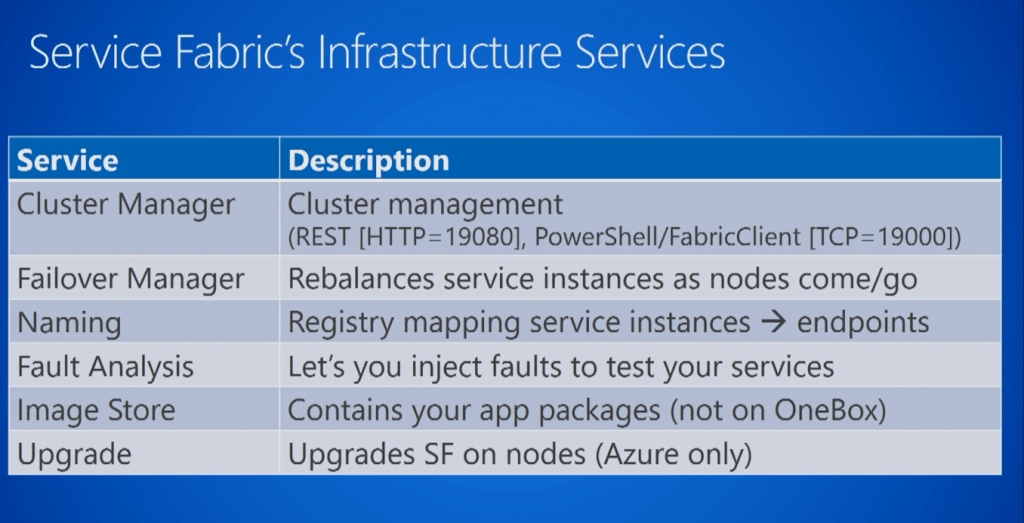
Intentions:
The service fabric works a bit like tools like Kubernetes in that you describe what you want to run, and how many of them, and the fabric takes care of the rest. This is done via the ApplicationManifest.xml file.
Prerequisites:
You will need to have the following components installed to run the code associated with this article.


